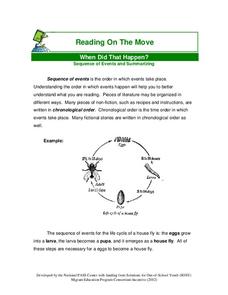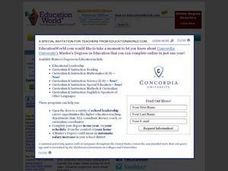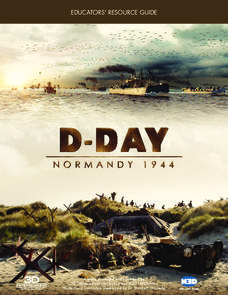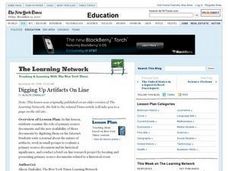Polk Bros Foundation
I Can Sequence Important Events
After reading any short informational or fictional text, ask your class to analyze the important events. They note down three important events on a short timeline, describing the events with either words or drawings. After this, pupils...
Crafting Freedom
Sequencing of Events in the Slave Narrative of Henry "Box" Brown
What steps did Henry "Box" Brown take while planning his own escape from slavery? Learners work in groups to analyze segments of Brown's narrative and identify the sequence of the most important events of his story.
Student Handouts
Pivotal Events
This is a simple graphic organizer that allows your class members to chronicle the progress and significance of a series of pivotal events.
Curated OER
Current Event Project
One of the best ways to make history relevant and engaging is to analyze current events before they become history! Check out these project guidelines for a current event research paper, outlining the major required sections of the...
Curated OER
When Did That Happen?
An awesome packet teaches individuals how to chronologically order and sequence events. The resource also provides practice that immediately follows the different ways to order events. Lastly, learners read a newspaper article...
Polk Bros Foundation
How to Summarize an Event in History or Today - or a Story
Ask your class to write a quick summary of a historical or current event. The worksheet offers a place to note down important details about the event, such as time, place, people, how it started, and how it ended. Pupils then take this...
Civil War Trust
Uncle Tom's Cabin
Through a careful reading and examination of Harriet Beecher Stowe's Uncle Tom's Cabin, scholars take part in grand conversations about the novel's contents, slavery, and the impact the book had on it. Furthermore, learners analyze an...
E Reading Worksheets
Summarizing Text
Help learners find the most important information in a text with a lesson on summarizing. As kids read through a passage about Johannes Gutenberg, they summarize small excerpts, put events in sequential order, and respond to two longer...
EngageNY
Presentation of Events: Comparing Two Authors
Give a little clue! Readers learn how context clues can help them determine the meaning of words by viewing a Context Clues Resource sheet then completing a Context Clues
practice sheet. They then compare events presented by two...
For the Teachers
Story Strips Sequencing
What happens next? Work on story sequence with a lesson plan that prompts kids to put a story back in order. Additionally, they discuss what would happen if one event was missing from the sequence.
News For Kids
News For Kids.net
Media lovers read articles on a variety of current events with a website made especially for kids. The website is easy to navigate and includes sections about everything from science to sports.
Curated OER
Working on the Slant
Compare and contrast a major news story from various newspapers. How does the perspective change? Are certain things included in some of the stories and left out of others? Have pupils complete a graphic organizer to compare how...
Briscoe Center for American History
Applying the SOAPS Method of Analyzing Historical Documents
Young historians use the SOAPS (Speaker, Occasion, Audience, Purpose, Subject) method of questioning to determine the historical value of primary source documents. The third in a series of five lessons that model for learners how...
For the Teachers
Sequence Plot Chart
Your kids can identify the plot sequence of a short story, but what about an informational article? Have them examine the chronological order of events in informational texts with a lesson on the sequence of events.
D-Day Normandy 1944
D-Day Normandy 1944
No study of World War II would be complete without an in-depth examination of the events of June 6, 1944. Pascal Vuong's D-Day Normandy:1944, is the perfect vehicle to convey the sheer magnitude of the events that have been called the...
Student Handouts
Before-and-After Chart
Keep track of what happens before and after an event, moment in a story, and so on, with a clear graphic organizer. Learners can note down four things that happen before and four that happen after on this chart.
Olympic Museum
The Olympic Symbols
Get into the Olympic spirit with a resource about the values and symbols of the Olympic Games. With sections about prominent images of the Olympics, including the flame and the interlocked rings, the packet supplies engaging information...
Curated OER
Writer's Craft: Foreshadowing
Track instances of foreshadowing in any text with a straightforward graphic organizer. In one column, learners note down the events that happened, and in the other they list the clues that indicated that those events would happen. Some...
Polk Bros Foundation
I Can Analyze Cause and Effect
Examine cause and effect by asking pupils to fill out a basic graphic organizer. The template is for any story or event and provides a line for writing in the story or event title. Pupils write in two causes in the circles and the change...
Student Handouts
Gains and Losses
What was gained? Lost? By whom? Why or how? Gains and losses are the focus of a worksheet that asks learners to chart both short-term and long-term gains and losses. A great way for class members to see the consequences of events.
Curated OER
Truth Be Told
Encourage your middle and high schoolers to share their memories of a recent event. After reading a New York Times article, they discuss Elie Wiesel's memoir, Night. They write their own memoir about a significant event that affected...
Stanford University
Civil Rights or Human Rights?
Young citizens consider the American civil rights movement as part of the global struggle for human rights. After using a timeline activity to learn about the major events in the civil rights movement, class members study Malcolm X's...
Curated OER
Digging Up Artifacts On Line
Why is it important to preserve historical documents and artifacts? Examine the role of primary source documents and the availability of these documents on the Internet. Middle and high schoolers write a journal about the nature of...
Stanford University
Observing Human Rights Day
How much intervention is appropriate for America to take in cases of human rights violations? Class members ponder a question that has lingered since the birth of America with a series of primary sources that reflect the degree to which...
Other popular searches
- Current Events
- Sequence of Events
- Sequencing Events
- Compound Events
- Current Events Newspaper
- Field Day Events
- Chemistry Current Events
- Current Events Rubric
- Independent Events
- Teaching Current Events
- Africa Current Events
- Health Current Events

























